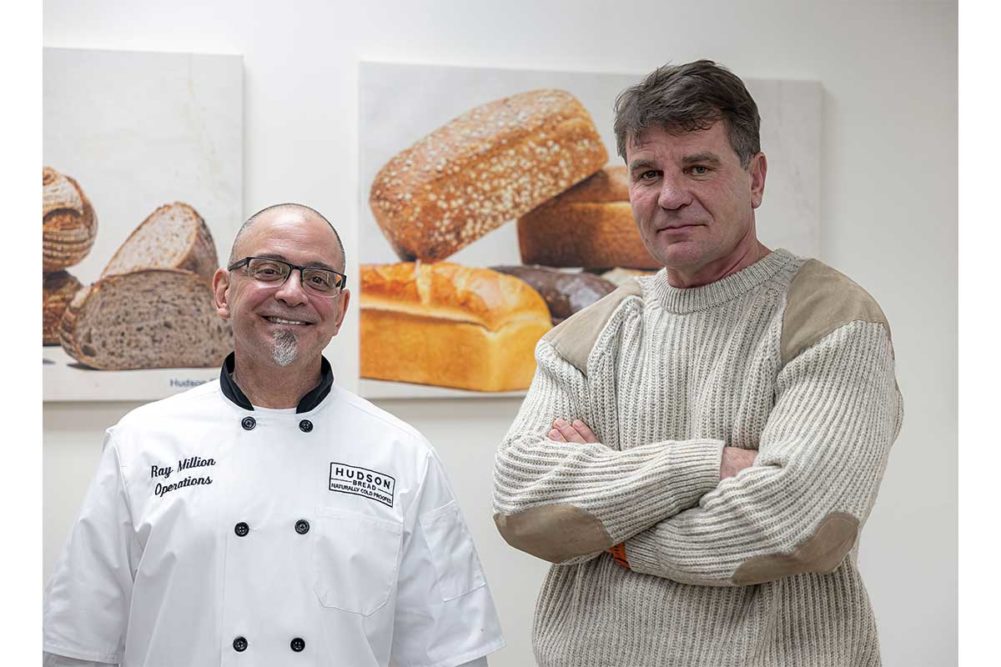Hudson Bread Co. is an artisan bakery unafraid of automation. That doesn’t mean the North Bergen, NJ-based company is willing to compromise on the rich flavor that takes time to develop or the delicate cell structure of its breads. What it does mean is Hudson Bread knows where and how to automate the process and where it pays to slow down and do things the old-fashioned way.
“Our philosophy is simple: Making the best of anything takes patience and skill,” said Ray Million, vice president of operations. “So our bakers slow the proofing process to develop depth in flavors and wholesome, unadulterated, delicious bread. After all, eating is about two things: nourishment and enjoyment, and we’re committed to both.”
Mariusz Kolodziej founded Hudson Bread in 1994, delivering artisan breads to restaurants, hotels, local cafes and other foodservice customers in New York City and New Jersey. The bakery developed a good reputation, and in 2005, moved into its current 60,000-square-foot facility to meet the needs of its growing customer base. With that growth came the need for automated equipment to handle the capacity and provide customers with consistent products: baguettes, artisan loaves, sliced breads, dinner rolls, focaccias, brioche, ciabatta and even vegan baked goods.
“Hudson Bread evolved from a strictly hands-on process in the early days as many artisan bakeries,” Mr. Million continued. “With new technologies and more efficient production processes along with adhering to making a delicious all-natural bread, we have established our brand. Recognition of the product, our service and commitment to our customers have fueled that aspect of growth.”
Hudson Bread has used technology and processes to not only meet growing customer demand but also improve product consistency, eliminate repetitive labor and build in some buffer against last minute orders. In today’s economic environment, with the cost of doing business rising, Hudson Bread looks for any way it can streamline operations and save money rather than risk raising prices too high.
“If I try to pass the cost to the customer, they’d be paying $20 a loaf,” Mr. Kolodziej said. “Like everyone else, we’ll add a couple of pennies to the price, but instead of raising our prices to the maximum, we try to save on the production end, which is why we’ve invested in Koenig lines, HB-Technik and MIWE. These investments allow us to be more precise, better and faster.”
It started with the bakery’s cold-proofing process, which it adopted in 2007. The bakery proofs its doughs at a lower temperature — 42F to 60F depending on formulation — and for a longer time, typically 12 to 24 hours. This not only has the benefit of building the finished product’s flavor, but it also allows the bakery to build an inventory and meet those last-minute calls from its customers across the Hudson River.
“We try to make 15% to 20% over just in case,” Mr. Million said. “We don’t know what will pop up at the end, so we want to make sure we can satisfy our customers by having the product available.”
As far as technology, ingredient handling is managed automatically with an HB-Technik system that produces the liquid preferments and natural starters. By automating the scaling of these and other ingredients, Hudson Bread has created more consistent doughs from batch to batch. Liquid ice is added to help control dough temperature instead of the traditional ice chips.
“Ice has the tendency to tear at gluten while developing the dough,” Mr. Million explained. “With the incorporation of the liquid ice, we can mix quicker and achieve the benefit of greater volume loaves.”
Liquid ice is a brine, water with enough salt to bring it below 32F while remaining liquid. It’s added directly into the dough, and dough formulations are tweaked to accommodate the added salt in the liquid ice. Not only does it help control dough temperature without damaging the gluten structure, liquid ice has the added benefit of cutting down on mixing times.
“It’s a novel technology to help us produce our doughs quicker and also have a stable control in the dough reaching the temperatures that are necessary because machines need a steady temperature for the doughs,” Mr. Million said.
The Koenig makeup lines — six in total — keep product consistent and meet growing capacity needs without compromising on the artisan quality.
The MIWE ovens are loaded and unloaded automatically with operators simply overseeing the process. An overhead conveyor transports product destined to be frozen to the cooler.
And for frozen packaging a Niverplast packaging line handles case erecting, sealing, labeling and quality control checks automatically. That packaging line only requires three employees. And there are plans in place for an investment in robotics in the future.
Even ordering has been streamlined with most of Hudson Bread’s customers placing bread orders through its online system, which has been established for years but really gained traction recently. Fresh orders are taken in daily, and a production report is generated from that system. Frozen products require a two-week lead time, during which the bakery will complete and store the products.
Sanitation is also an ongoing endeavor with six employees cleaning throughout the day. Equipment is disassembled and cleaned at the end of the day. Because Hudson Bread is still mostly a fresh bakery, it runs one mixing shift and three baking shifts — 4 a.m. to noon, noon to 8 p.m. and 3 p.m. to midnight — to keep up with its daily orders.
This article is an excerpt from the April 2022 issue of Baking & Snack. To read the entire feature on Hudson Bread Co., click here.





